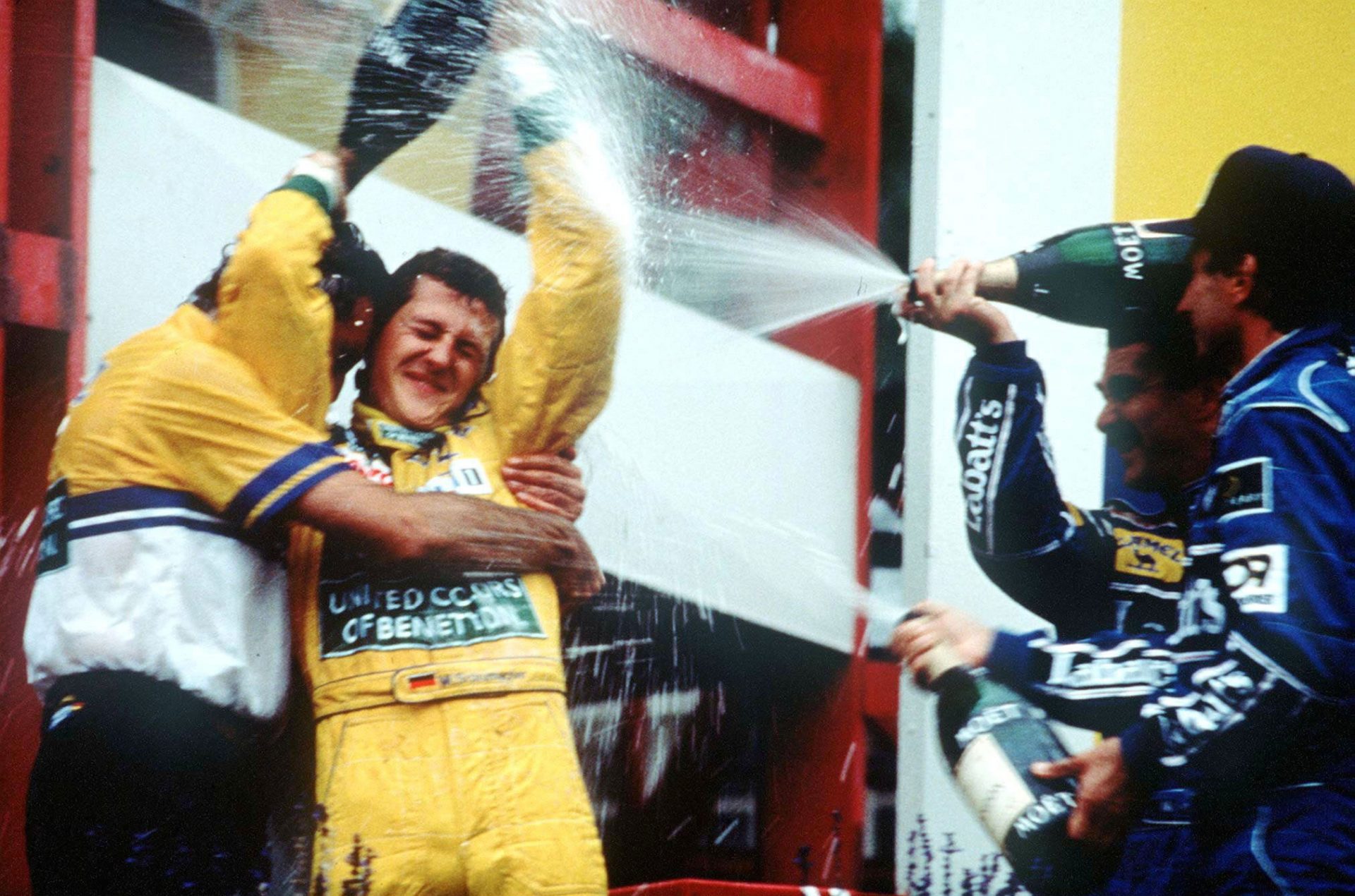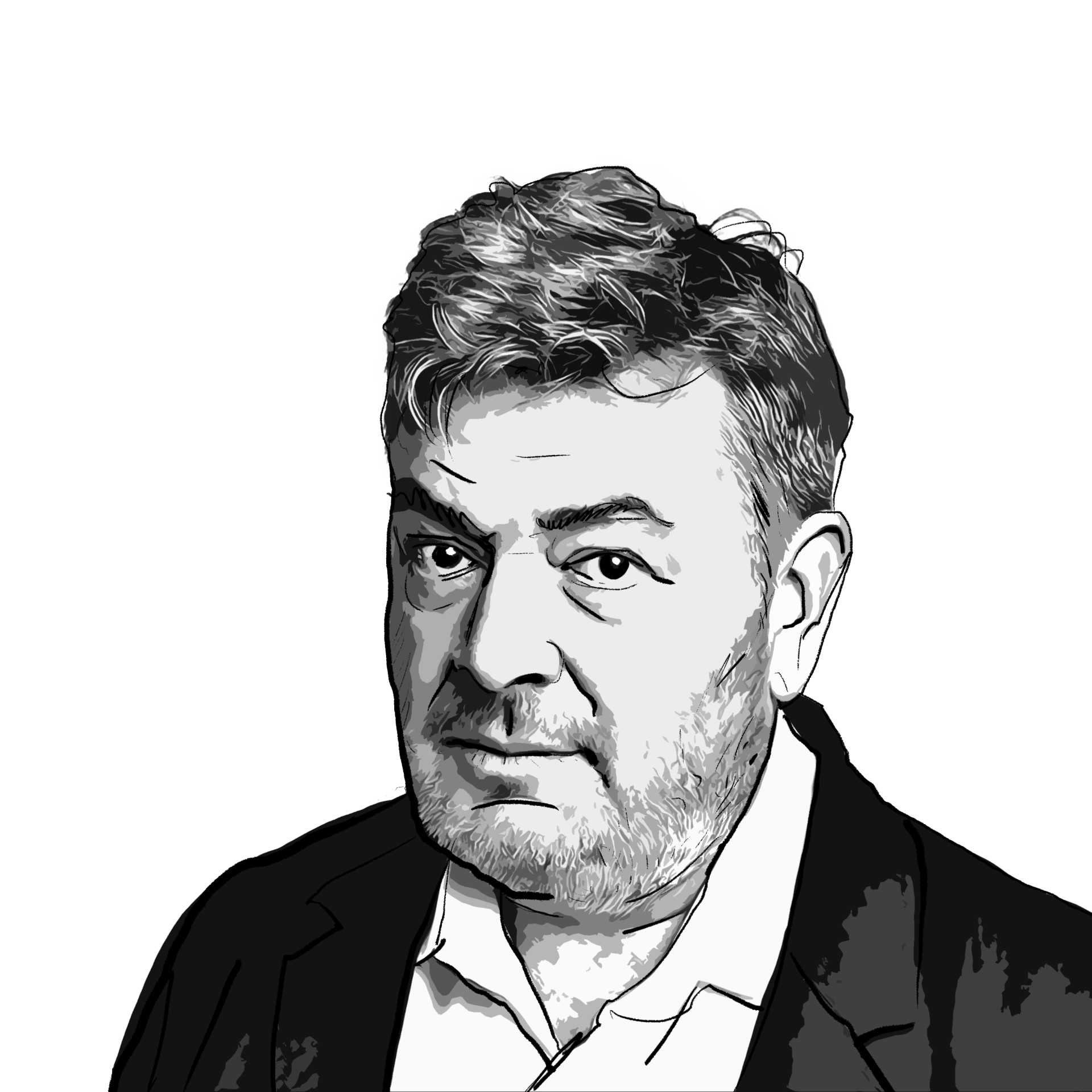The Belgian Grand Prix is among the most sacred races on the Formula 1 calendar.
Nestled in the Ardennes Forest, halfway between the city of Liege and the German border, the fearsome Spa-Francorchamps track has a reputation for sorting the great from the good.
Only the best win there. Jim Clark did it four times, Ayrton Senna five.
One man, though, conquered it six times. And it was at Spa that his legend began, 25 years ago.
It was fitting that last month’s Belgian GP was preceded by an emotional lap of honour for Michael Schumacher, undertaken by his son Mick in his father’s title-winning 1994 Benetton. Now 18 and driving in Formula 3, Mick was alongside Michael on the slopes in Meribel in December 2013 when, crossing an unsecured off-piste area, his dad fell and hit his head on a rock, setting in motion a chain of events which have seen him become the world’s most shielded patient.
But then it was entirely appropriate too that Schumacher senior took took the very first of his remarkable 91 Grand Prix wins at Spa. Just a year earlier he had made his F1 debut at the circuit after getting his shot at the big time in the most bizarre of circumstances.
In 1991 Schumacher was a promising but largely unknown young driver in the Mercedes junior sportscar programme when a traffic incident at London’s Hyde Park Corner changed his life – and the course of motor racing history – forever. Bertrand Gachot, driving for the fledgling Jordan Grand Prix team, got into a row with a London cab driver which ended with Gachot spraying him in the face with CS gas.
Expecting a fine when the case came to trial in August, the Frenchman was stunned when he was handed a six-month prison sentence. Suddenly team boss Eddie Jordan needed a driver at very short notice.
Schumacher’s wily manager Willi Weber saw his chance, and partly thanks to an assumption that Schumacher already knew the Spa track (in fact, he had never driven it), and partly because Weber convinced Mercedes to pay cash-strapped Jordan $150,000, he was given the nod.
The lean, fresh-faced German with the wide smile and pronounced chin turned up at Spa and stunned the paddock. In his very first competitive run in an Formula 1 car he qualified an astonishing seventh. It was the highest grid slot a Jordan car had ever achieved – and he was almost eight-tenths of a second quicker than 11-year veteran Andrea De Cesaris in the sister car. In the ultra-fast world of F1, that was a lifetime.
That his first race did not even last a full lap – his clutch blew after just a few hundred yards – did not matter. No-one had ever seen anything like it from a rookie and he instantly became the hottest property in the sport.
Come the next race at Monza, Schumacher was wearing the united colours of Benetton, having been snatched from Jordan’s clutches by the Anglo-Italian team.
‘Welcome to the Piranha Club,’ a furious Jordan was told by a rival team boss.
With highly talented engineers like Ross Brawn and Pat Symonds running the Benetton technical set-up, Schumacher found himself in F1’s coming force and everyone knew stardom beckoned for him. But no-one predicted the young German would go on to redefine what it was to be a modern F1 driver – or that he would completely re-write the record books before he was finished.
Fast-forward 12 months and he was back at Spa and ready to step into the winners’ circle with a performance that carried all the hallmarks of many of his finest victories.
Driving a slower car than his rivals, he used the wet/dry changeable conditions to his advantage, understanding the constantly evolving grip levels better than the rest. But there was another telling element to that first victory which offered a glimpse into how Schumacher won dozens more races than any other driver in the history of the sport.
After flying off the track and losing a position to team-mate Martin Brundle, Schumacher rejoined and noticed Brundle’s wet tyres were starting to blister on the drying track. He pitted immediately to switch to dry tyres, a decision that won him the race.
‘That was a clever thing of Michael to do, in the heat of the moment, having just gone off at a fast corner, at Spa, in the wet. Remarkable,’ Brundle said later. ‘It’s those pivotal moments that make the difference between being good and being great. I think that story shows the mental capacity he had – even then, in his first full F1 season – to drive an F1 car on the ragged edge and at the same time think analytically about what was going on around him.’
Schumacher would use that mental capacity to devastating effect many times in his career, especially as part of his famous double act with Brawn, who not only masterminded his two world titles at Benetton, but then followed him to Ferrari where the pair turned the Prancing Horse into a relentless winning machine, taking an incredible five drivers’ championships in a row.
‘Michael often won races he shouldn’t,’ Brawn says. ‘In 2004, for example, people thought we were cruising to the championship. But it wasn’t like that. We were at the pit wall doing calculations and we had situations where we knew we were very marginal.
‘We had a few races where everything had to go perfectly for us to win and they were satisfactory because everything did fall into place. That was down to Michael producing some amazing lap times when we asked him to.’
As well as a level of tactical nous not seen before from a driver, Schumacher also brought an unprecedented level of fitness to F1.
‘I want to be 200% physically prepared,’ he once said. ‘Even at the end of the race I want to have something in reserve; I don’t want to feel tired at any point because that will affect my ability to drive the car on the limit.’
His dedication forced the other drivers to reluctantly follow suit. ‘Michael’s fitness was a pain in the ass,’ Grand Prix winner Gerhard Berger said. ‘We were all pretty fit back then because we had to be, but Michael proved that there was fit and fit; suddenly we had our teams asking why we weren’t as fit as him and we all had to train more as a result. You can imagine what I thought about that!’
As his exasperated rival Damon Hill once remarked after a particularly gruelling race: ‘He never seems to sweat, does he?’
Schumacher’s approach outside the car was just as revolutionary. The great Ayrton Senna was renowned for getting the best out of his team. The German went one better: he built his own team around him and then ensured it was entirely dedicated to helping him win.
In his 10-year spell at Ferrari, he was part driver, part team manager, part motivator-in-chief – and unlike many drivers before him, he was willing to put in just as many hours as everyone else.
‘F1 team people live and breathe their work, but that’s not always reflected in the driver,’ says his former race engineer Pat Symonds. ‘Michael always, always put in as much as everybody else, and more.
‘That lifted everyone, so we’d raise our game further. You think, I can’t possibly work any harder, and somehow you just find that extra little bit.’
One motivating factor for Schumacher’s team was the knowledge that he would always get a result. Sometimes he went too far. Unsavoury collisions with Hill and Jacques Villeneuve, both in title-deciding races, shocked fans.
But Symonds says that was all down to his ruthless will to win. ‘Michael is as good as he is because he’s so competitive… occasionally his competitive instincts have got the better of him, and then he doesn’t think, he reacts.’
Such incidents made Schumacher a pantomime villain among British F1 fans but did nothing to stem his incredible popularity in his native Germany – a country steeped in motor racing tradition yet one without a single World Champion until Schumi came along and single-handedly created a huge fanbase for F1 in Europe’s biggest economy.
‘We needed him,’ said former F1 ringmaster Bernie Ecclestone, who was delighted when Michael burst onto the scene in 1991. ‘He was fast, he was young and he was German – he ticked all the boxes.’
That Schumacher was the most popular driver on the planet was made plain by the outpouring of support after his 2013 accident, in the aftermath of which he spent nearly six months in a chemically-induced coma to prevent swelling to his brain which surgeons were unable to remove.
Doctors said he would have been killed had he not been wearing a helmet but even four years on, we know precious little about his condition thanks to his family’s policy of absolute secrecy. ‘Michael’s health is not a public issue, and so we will continue to make no comment in that regard,’ his spokesperson Sabine Kehm has said, talking of a desire to protect the stricken champion’s ‘intimate sphere’.
Schumacher is reported to be paralysed, wheelchair-bound and to suffer from speech and memory problems, but none of these facts have been confirmed officially – and they may never be. The only thing we know for certain is that last year, some two-and-a-half years after his fall, he could not walk or even stand unaided. Those sad facts were confirmed by a family lawyer, Felix Damm, in a privacy action against German magazine Bunte, which had claimed a recovering Schumacher was now able to take a few steps.
After reports that a journalist dressed as a priest had tried to gain access to his hospital room in Grenoble, the seven-time world champion is now thought to be under medical care at his home near Lake Geneva. Even that sanctuary may have been breached – last December, three years on from the accident, a photograph of Schumacher apparently taken there by an unknown person was being hawked around newspapers and agencies for a seven-figure sum.
The secrecy has fuelled speculation and earlier this year Weber urged the family to ‘pour some wine’ for fans by revealing more about their idol’s condition, good or bad. Even the man who was Schumacher’s closest adviser remains largely in the dark, although he revealed he remains foremost in his thoughts. ‘When I’m home alone and the phone rings, I often feel that it will be Michael saying ‘Willi, how’s it going?’ Hope dies last,’ he said.
While his condition carries a macabre fascination for some, it is Schumacher’s legacy as a driving champion which will endure. Wins, fastest laps, world championships: he holds the records for them all, and 25 years on from his first win, he is still the benchmark by which every driver in the sport measures himself.
Consider this amazing fact: between 1992 and 2004 there were only two ways to win a Formula 1 world championship: one was to be driving a car created by design genius Adrian Newey. The other was to be Michael Schumacher.
Rob Burnett is F1 editor of DriveTribe.com











